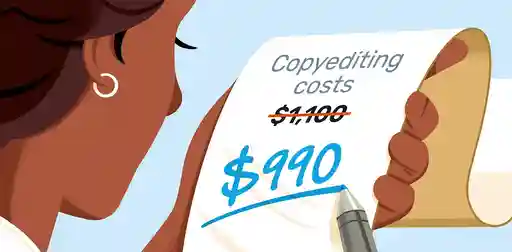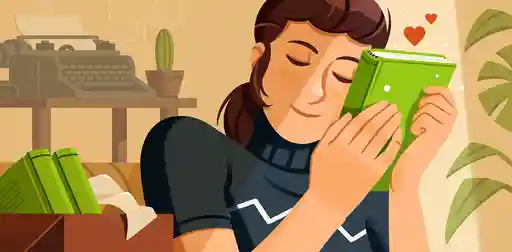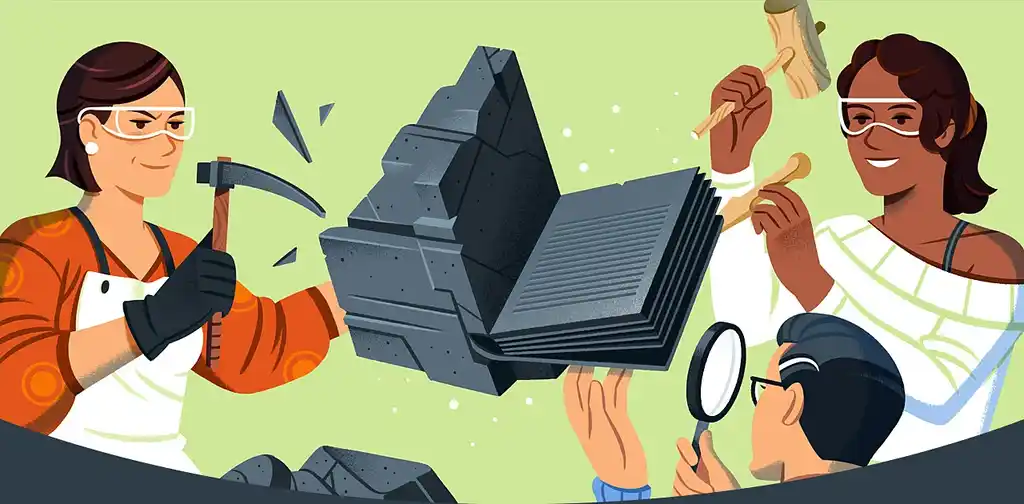Blog • Understanding Publishing
Last updated on Jun 03, 2022
What is Line Editing and How Can It Help Your Book?
In the context of publishing, a line editor is a professional who will work through a manuscript, line-by-line, with a laser-sharp focus on style, consistency, and overall readability. It’s much more than a simple proof — and if you value your voice as a writer, line editing is non-negotiable.
However, if you’d like to learn more about line editing before hiring an editor — or if you’re hoping to get a start on the editing process yourself — read on for more info and line editing tips!

MEET EDITORS
Polish your book with expert help
Sign up, meet 1500+ experienced editors, and find your perfect match.
What is line editing versus copy editing?
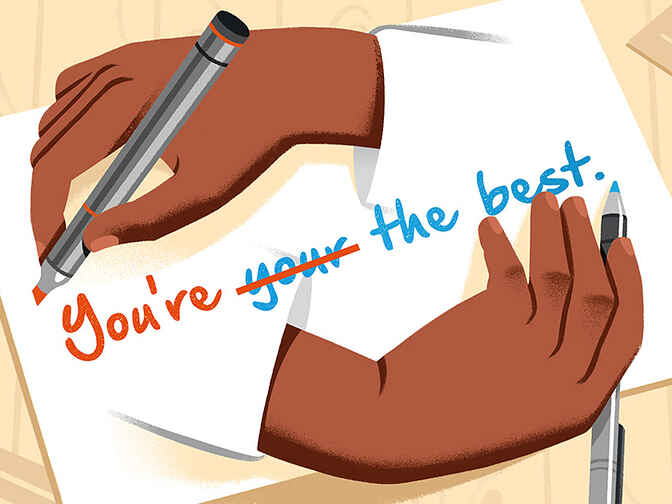
Line editing is a part in the book editing process where the editor aims to improve the clarity of a piece of writing. A professional line editor examines the manuscript on a sentence level, leaving suggestions for word choice, syntax, and tone to enhance the author’s writing style and the text’s overall effectiveness.
Let’s add to this now by clarifying the issue of copy editing vs. line editing. Copy editing is a general term for editing a piece of text, encompassing mechanics like spelling, grammar, and punctuation. Line editing is a more in-depth version of copy editing, one that focuses on style as well. Both types of editing aim to produce more readable prose, but line editing is more nuanced.
Basically, standard copy editing is fairly cut-and-dried, while line editing includes more subjective, interpretive stuff. If you’re still not sure about the difference, check out our examples of copy editing vs. line editing below! But first, take a look at the untouched passage:
There was no possibility of taking a walk that day. We had been wandering, indeed, in the leafless shrubbery an hour in the morning; but since dinner (Mrs. Reed, when there was no company, dined early) the cold winter wind had brought with it clouds so sombre, and a rain so penetrating, that further out-door exercise was now out of the question.
Fans of 19th century literature will recognize this as the opening to Jane Eyre, which is arguably already flawless. However, humor us for a moment and imagine that two different editors — a copy editor and a line editor — have been tasked with updating the prose to be more accessible, while remaining true to Charlotte Brontë’s voice.
Copy editing vs. line editing examples
Given those instructions, the copy editor might make the following changes:

NOTE A: Superfluous phrases; delete for concision.
NOTE B: Split lengthy sentence into two sentences.
NOTE C: No need for a comma here anymore.
These copy edits make the passage more clear and concise for the modern reader. However, a line editor would adjust even more:
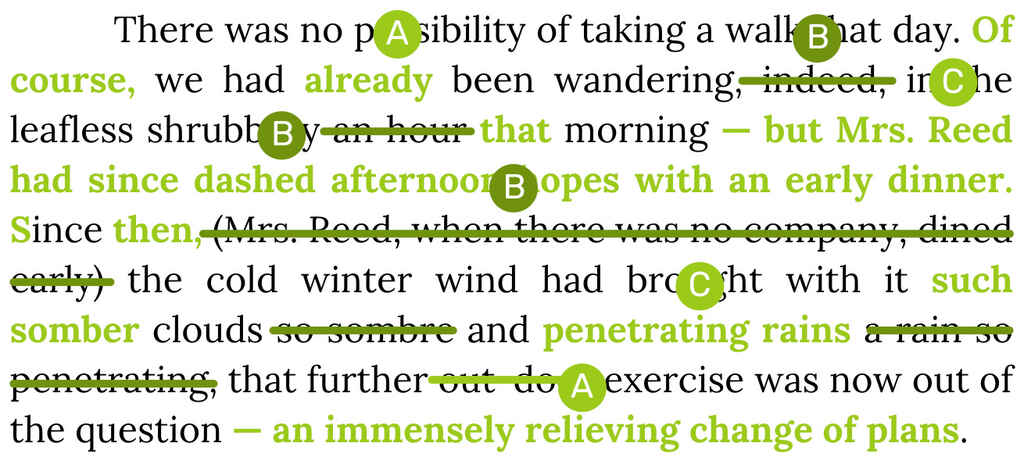
NOTE A: To show Jane's dislike of walking.
NOTE B: Superfluous phrases; delete for concision.
NOTE C: Stronger phrasing re: Mrs. Reed and the weather.
In addition to technical edits like deleting redundant phrases, this line edit bolsters the passage with better phrasing and a new layer of meaning — we realize that Jane isn’t fond of walking, especially in the cold. This is the power of line editing: it doesn’t merely fix the prose, it builds on it to improve the reader’s overall understanding.
Let’s break down the line editing process even more. Say you've just finished writing an 18th-century paranormal romance called Heartblood. The story seems destined for the big screen, the characters are vivid and interesting, and the spelling and grammar are pretty good.
However, the prose itself could use a bit of… finessing. Time for a thorough line edit! Here are some more ways that line editing can upgrade your book — with sample passages and bullet points to show exactly what a professional editor might suggest.
It strengthens the prose with better word choices
Line editing facilitates strong, precise word choice and gets rid of clichés. A professional editor would note where word choice can be improved and what they'd use instead, as we’ve done below this passage.
Clothilde hugged Janus. As star-crossed lovers, they felt like the whole world was against them. It made Clothilde feel bad. Thinking about her fellow vampires' negative response to Janus' meaty fragrance, Clothilde couldn't help but weep tears of fresh blood.
- “Star-crossed lovers” and “the whole world was against them” are clichés you want to avoid. Use stronger language to bring your characters’ situation to life.
- “It made Clothilde feel bad” — weak word choice. Be more specific!
- Is “meaty fragrance” really what you want here? Why not “scent”? And why were the vampires reacting negatively? Clarify in this passage, even if only to remind the reader of how painful it was for Clothilde.
- Overall, try describing what Clothilde feels rather than what’s simply happening to her — do your best to show, don’t tell!
The final prose-strengthening line edit might look like this:

Trims the fat for a tighter reading experience
Line editing will also ensure that your syntax is concise. Cutting sentences and even whole passages is one of the most difficult parts of editing, but that's what a line edit is for!
Janus was on his way to a meeting of the wizard's council when he saw the broadsheets being passed out on the street that clearly had something to do with the embezzlement case Clothilde was investigating, even if he couldn't see the lettering very clearly. Clothilde's investigation of the embezzlement was not going well. His trip to the council meeting was also now going to be similarly derailed.
- The first sentence is long and unwieldy. To make it easier for readers to navigate, break it up and condense the language.
- Unnecessary repetition — you don't need to mention “Clothilde's investigation of the embezzlement case” right after “the embezzlement case Clothilde was investigating”.
- In the last sentence, you don't need “also” and “similarly”.
The final condensing line edit might look like this:

Fills in gaps that could confuse the reader
Crucially for your story, a line edit will also fix plot and character inconsistencies. These may be as significant as a missing plot point, or as simple as a descriptive blunder, like this next excerpt.
Clothilde gagged at the smell of blood. Janus regarded her, now clearly in pain, with mild disinterest.
- Isn't Clothilde a vampire? Why would she gag at the smell of blood, which she presumably drinks? If she's truly repulsed, explain why; if not, change the reaction to something less negative.
- Furthermore, why does Janus respond to her pain with “mild disinterest”? Aren't they supposed to be deeply in love?
The final clarifying line edit might look like this:

Improves the flow by correcting mood and tone
Finally, a line edit will correct writing that strikes the wrong tone. This is especially important during dramatic and/or climactic scenes, like the following passage.
“Clothilde!” Janus screeched, as her eyes dimmed and dulled. The stake stuck out of her shapely chest at an angle that made it look like a light switch in the off position. The embezzler giggled. Janus glared at him indignantly and pulled the stake out with a squelching sound.
- This is meant to be the book's tragic climax, but the odd tone makes it anticlimactic. Adjust your word choice to convey the gravity of the moment — you might try better verbs for “screeched” and “giggled”, and change phrases like “glared at him indignantly” and “squelching sound”, which sound a bit silly and make the stakes feel low.
- Is her death scene really an appropriate time to comment on Clothilde's “shapely” chest? Choose a more solemn descriptor for the moment (like “heaving” or “bleeding”) or remove the word entirely.
- The light switch simile is out of place because of the novel's setting — as an 18th century wizard, Janus wouldn't know what a light switch is! Be careful of anachronisms like this when writing historical fiction.
The final tone-correcting line edit might look like this:

Final tips for self-editing
By now you should have a pretty strong sense of what line editing is and why it’s important! If you plan to self-edit, however, here are some final tips to make sure your edit is effective.
Do:
✔️Set your manuscript aside for a few days. Let your own language become new to you again. Only then can you approach it as an editor.
✔️Read everything out loud. Do your sentences flow well? Does the order make sense? Does the dialogue sound natural? If you find yourself gasping for breath before the end of a sentence, consider slicing it up. If you stumble over a certain word, rework or cut it.
✔️Audit for your own personal clichés. You already know to avoid the common ones — expressions like “in the nick of time” and “raining cats and dogs”. But writers should pay attention to their own stylistic quirks as well!
For example, do you use way too many semicolons? Do your characters constantly “chortle” instead of laugh or “declaim” their words instead of saying them? Whether or not these choices were intentional while writing, be mindful about them during your line edit.
Don't:
🚫Become a thesaurus junkie. When it comes to improving your word choice, a thesaurus can definitely help. But going overboard with it will ruin your prose — transforming blue eyes into “ultramarine orbs” and bad feelings into “substandard affections”.
🚫Insult your reader. When editing your manuscript for clarity, you may be tempted to make some edits in order to, well, clarify your prose. But don’t go too far and start spoon-feeding your readers! They're smart and should be guided through the story by a similarly discerning author — not stuck with interpretive training wheels.
🚫Refuse to ask for help. Even if you decide not to hire a professional editor, that doesn't mean you must go it alone. Consider seeking out beta readers or even joining a critique circle for some third-party feedback.
Now that you’ve learned about this crucial type of editing, you can use your knowledge to turn out a book as polished as your ideas deserve! Whether you end up hiring a professional or engaging your inner editor, your manuscript (and readers) will thank you.


